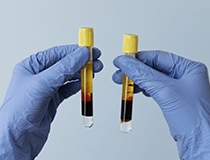Many of the latest medical treatments use platelet-rich plasma (PRP) in various ways. Using the natural regenerative properties of PRP, doctors can administer minimally invasive solutions for managing pain and repairing damaged tissue.
There are plenty of benefits to choosing treatment PRP options. However, patients should also know the risks to make informed choices. If your doctor recommends PRP treatment for your condition, they will guide you through the benefits and risks. This blog discusses the risks associated with PRP therapy so you know what to expect and how this treatment can benefit your recovery or pain management plan.
What Is PRP and How Does It Work?
Platelet-rich plasma is a substance taken from your blood. Before any PRP therapy, a qualified professional will extract a blood sample. This sample will be processed in a centrifuge to separate the blood cells and other components from a concentrated plasma of your platelets, or PRP. This substance has up to 10 times the number of substances that promote cell growth and healing.
During treatment, the PRP is injected into the affected area. A medical professional may use an ultrasound to ensure the PRP is applied to the site with tissue damage. The PRP will then stimulate cell growth and repair, promoting faster recovery.
While some patients may notice the effects of PRP treatment following their first injection, most patients require more than one PRP injection to achieve the best results. PRP is usually administered in three injections, with sessions spread three to six weeks apart.
What Are the Benefits of PRP Treatments?
PRP therapy provides numerous benefits, including:
- Reduced Inflammation: PRP treatments are often recommended for patients with inflammatory musculoskeletal conditions, including arthritis and tendonitis. It can help with managing pain and restoring mobility.
- Non-Surgical: As a minimally invasive treatment, it has fewer risks and complications than surgical intervention. No incisions are needed, and little to no recovery time is required after the procedure.
- Hypoallergenic: PRP is made from your own blood, so the risks of an allergic reaction or adverse side effects are significantly reduced.
What Are the Potential Risks of PRP?
No treatment is without risk, and there are some potential risks involved with treatment PRP procedures. Most of these risks are common in other procedures that involve needles. In the hands of a capable provider, these risks are very low. However, knowing these risks can help you make informed decisions about your treatment plan.
Infection
There is always some bacteria on your skin, so medical professionals must disinfect the skin around the injection site before inserting a needle. However, improper disinfection and an unclean environment can result in the needle getting in contact with bacteria and pushing it past your skin. This is a common risk in all treatments that involve injections.
To prevent this, the medical professional extracting blood or administering PRP should take steps to disinfect the injection site carefully. Following each injection, they should cover the site with a clean cotton ball and instruct you to put pressure on the area.
Nerve Injuries
When a needle is inserted, there’s a risk that the needle can hit and damage a nerve in the area. At the very least, it can cause some amount of pain. However, there’s also a risk of nerve damage, which can lead to side effects such as numbness, tingling, weakness, or loss of sensation in the affected area. In rare worst-case scenarios, it can cause paralysis.
To prevent this, the professional administering PRP should be careful about where they insert the needle. During PRP treatments, medical professionals often use ultrasound imaging to guide them.
Pain at the Injection Site
Like any other injection procedure, PRP treatments may result in some pain at the injection site following treatment. This is your immune system’s reaction to the injection penetrating your skin and entering your body. When a foreign object enters your body, it triggers inflammation and pain to eliminate any threats. This can result in mild pain up to several days after treatment.
For most people, this pain and discomfort is unavoidable with injections. However, you can mitigate the pain with over-the-counter pain relievers. If the pain persists after several days, visit your healthcare provider to determine if the pain comes from nerve injuries.
Tissue Damage
Tissue damage can occur if the needle is too big, inserted at the wrong angle, or administered in an area with accumulated scar tissue. This can cause inflammation, pain, and discomfort. However, capable doctors can ensure they use the appropriate needle length in the body.
What Is the Impact and Recovery Time for PRP Injections?
PRP treatments do not need recovery or downtime periods, so you can resume your daily activities after your treatment. However, if you’re seeking treatment PRP solutions for injuries and musculoskeletal conditions, it’s recommended that you rest your affected area. There are also some recommended aftercare practices to prevent bruising and minimize pain.
Some patients experience a significant difference from their treatment after one session. However, other patients may need multiple treatments before noticing an improvement in their pain or mobility. PRP helps your body by supplying the damaged tissue with platelets that promote cell growth around the affected area.
Schedule an Appointment for Safe PRP Treatments
PRP treatments can have promising effects on patients who want to recover from musculoskeletal conditions and other injuries. While there are benefits to taking PRP treatment, patients should be aware of the risks and side effects. Most of these are common side effects as a result of the injection and can go away on their own after several days. However, the risk of more serious side effects can be minimized when you receive treatment from a capable medical provider.
At Chicago Stem Cell & Regenerative Medicine, our qualified medical providers can mitigate the risks during treatment. We ensure our patients understand the treatments they’re receiving and how they help them recover or manage their condition.
If you would like a comprehensive and personalized treatment plan for your condition schedule a consultation with our doctors today through our online form or call (630) 920-2323.


 Thanks a lot for getting my hip right. Looking forward to a full recovery and a great season. Thanks again for everything.
Thanks a lot for getting my hip right. Looking forward to a full recovery and a great season. Thanks again for everything.










